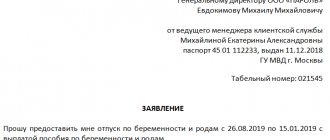The concepts of maternity leave and maternity position
Before considering the situation related to working on maternity leave, let’s understand what the concept of “maternity leave” means.
When a pregnant woman begins to take leave at work related to pregnancy and subsequent care for the newborn, a vacant position appears.
That is, the employer has the right to hire another employee for this position. When concluding an employment contract, the terms and conditions of the new employee’s work are stipulated.
Note ! The hired employee must understand that if a woman on maternity leave returns to work, he will be fired or transferred to another position.
A maternity position is a temporary vacancy that appears due to a pregnant employee going on maternity leave.
The concept of “maternity leave” is absent in the Labor Code of the Russian Federation. In this regard, there are officially two types of leave: maternity leave and leave to care for a newborn.
If the first lasts until the baby is born, the second begins after his birth. A woman can care for a child up to three years old.
First, parental leave is issued until the child is one and a half years old, and then until he is 3 years old. Both of these periods are documented after submitting the application. Collectively, these days of rest are called maternity leave.
Important! It is mandatory to indicate the length of time a woman will be on maternity leave.
Features of maternity leave and maternity pay
According to the legislation adopted in Russia, if a woman becomes pregnant, she has the right to go on maternity leave, and after giving birth she will receive payments assigned for caring for a newborn.
At the same time, the employee (whether it’s mom or dad) retains his job until he returns from maternity leave. Both dad and mom, according to Russian law, have the right to go on maternity leave. However, it should be remembered that in order to take such leave, you need to provide certain documents.
The employer by law has the right to hire a new employee on maternity leave. He will temporarily perform the duties of an employee who has gone on maternity leave. The concluded contract with a temporary employee must contain a clause stating that the person is being hired on maternity leave. You can also specify in the document what will happen to the person before the old employee leaves maternity leave (transfer to another position or dismissal). In this case, the hired employee will be entitled to annual leave.
A fixed-term contract is a document signed when hiring a temporary employee.
When a person is registered as a temporarily free employee, a fixed-term employment contract is concluded with him for a certain period. This is due to the fact that the employee is on maternity leave. The document contains an indication that the employee is provided with a workplace for the period of absence of the main employee, in other words, until he returns from maternity leave.
Sometimes the employment contract specifies a specific date for termination of the contract, which is the end date of the period of absence from work of the main employee.
The specificity of a fixed-term contract essentially lies in the fact that it is concluded for a certain period of time, namely for the period the main employee is on maternity leave or until the day the contract with the person being replaced is terminated.
Whether or not to work in a temporary position is up to each person to decide for himself. Like any type of activity, working under a fixed-term employment contract has its advantages and disadvantages.
Let's list the advantages:
- Having a job. If a person needs a permanent source of income, then he will even agree to employment under a fixed-term contract. This is especially true for specialists who have recently graduated from an educational institution and are ready to work for some time to gain experience, skills and knowledge. Workers with young children do not enjoy the favor of their employers, because the children periodically get sick, and mothers are forced to issue paid sick leave certificates.
- Decent wages. Sometimes employers encourage female employees to work under a fixed-term employment contract by paying them bonuses and bonuses.
Among the disadvantages it is worth noting the following points:
- The nature of the work is temporary; the main employee can return to work at any time and begin his duties.
- Interruption of work experience. If the termination of a fixed-term contract occurs unexpectedly, then the person will need time to find a new job, and accordingly his work experience will be interrupted for an indefinite period.
- Losing your job when going on long vacation. If the main employee returns to work while his replacement employee is on maternity leave, the employer will terminate the fixed-term contract with the second employee.
- Lack of child care payments.
- Difficulties joining the work team.
The rights of a temporary employee are limited by labor legislation
The rights and labor responsibilities of a working person are enshrined in Article 21 of the Labor Code of the Russian Federation. When signing an agreement, employers and applicants must be aware of and comply with mutual written agreements. A person who works receives a salary, and the manager pays it on time, in full, including all compensation payments. The right of one party is the duty of the other.
The rights of an employee under the labor code are listed in Art. 21 Labor Code of the Russian Federation. A person has the right:
- sign, change and supplement, terminate the employment contract, observing the rules specified in regulations;
- apply for the activities set out in the employment contract;
- work in an organized labor process;
- receive a salary for the work specified in his contract;
- have a place equipped in accordance with regulatory labor protection requirements;
- have equal pay for equal work without any discrimination;
- rest during paid leave on an annual basis, take days without pay;
- demand that the organization’s managers fulfill the terms of contracts;
- protect your rights by all legal means;
- appeal against the actions of the organization’s employees in the field of labor and other relations directly connected with them;
- receive compensation for material damage caused to health if it was received during the performance of work duties;
- participate in trade unions;
- receive a refusal to perform work activities if facts arise that pose a threat to his physical health;
- receive information in areas related to the labor function specified in the contract, including full access to complete and reliable information about the state of labor conditions and safety;
- arrange life and health insurance for subordinates on the part of the employer;
- keep confidential personal data stored by the employer.
Even if a person works on a temporary basis, he is provided with all the basic rights enshrined in the Labor Code of the Russian Federation. Violation of the rights of a working citizen entails bringing the employer to administrative and even criminal liability.
Labor legislation protects a woman while she is waiting for the birth of her baby, even if she works under a fixed-term employment contract. She receives financial support from the state in the form of maternity benefits, the amount of which depends on the amount of official income for the previous two years of work of the expectant mother.
https://youtu.be/8N2i-OCy-mU
Is it possible to go on maternity leave from a maternity place?
How will events develop if a new employee leaves her maternity position due to childbirth?
Will she also be able to take maternity leave? The law is on her side, although there are some peculiarities in this situation. When a new employee is hired to replace a woman on maternity leave, a fixed-term employment contract is signed with her, which necessarily specifies the expiration date of its validity - the time of the previous employee’s return to work.
Usually this date is known exactly, as it is indicated in the application when applying for leave to care for a child (up to one and a half years). After signing such an agreement, the woman has the opportunity to extend it over time. The fact is that often mothers, while on maternity leave, understand that they are not yet ready to leave their one-and-a-half-year-old child in someone else’s care, and therefore write an application to extend the vacation to 3 years.
Since the date of a woman’s return to work is shifted by another year and a half, the employer can extend cooperation with an employee who worked in a maternity position.
It's easier than looking for a new employee. Moreover, an employee always has a chance to sign an open-ended contract, since sometimes young mothers decide to change their place of work due to the birth of a child.
When a new employee goes on maternity leave, all the rules established in this situation are observed in relation to her: payments, deadlines, etc.
Before giving birth, a woman takes out maternity leave, even if she worked on maternity leave. She is provided with rest for up to 140 days (during normal pregnancy). If the birth was complicated, the vacation period will be 156 days. If several babies are born at once, the period of prenatal leave will be 190 days.
Maternity leave will be a little more difficult. If the previous employee has not yet returned to work and does not intend to do so in the near future, her “replacement” can count on maternity leave.
When to apply for maternity leave?
Leaving maternity leave: is it possible?
No one can prevent staff from leaving work on a fixed-term contract. But in this case, a woman who plans to have children, and at the same time is in the place of a deputy, will herself be interested in receiving sick leave and corresponding payments.
Based on the provisions of regulatory legal acts that are relevant in 2020, we can say that when leaving a maternity place on maternity leave, the head of the organization who has drawn up the contract undertakes to agree upon application for maternity leave for a period corresponding to the severity of the situation of the expectant mother. Maternity leave is only permissible in cases where a permanent employee refuses to leave or quits altogether.
Can they fire me?
What happens if a girl goes on maternity leave herself without formalizing it?
It is not advisable to do this. Most likely, she will be fired, but only on the day when the employment agreement expires. Although if this date falls during prenatal leave, the contract will be extended until the birth of the child. As soon as the child is born, the woman will be fired.
When an employment agreement is extended due to the fact that the previous employee does not intend to return to work yet, and the new employee is on maternity leave, she has the chance to take maternity leave.
In this case, dismissal will occur when the employment agreement expires or when the former employee returns from maternity leave.
Dismissal while on sick leave is not possible. So if sick leave is issued for the prenatal period, no one has the right to fire such an employee. This is a violation of the law.
So if you work in a maternity position and you are about to become a mother yourself, do not be afraid to take prenatal leave. At least no one will fire you before you give birth.
Criminal liability for dismissal of a pregnant woman.
Is it possible to fire a pregnant woman under a fixed-term employment contract? Read here.
How to make maternity payments for free, read the link: https://novocom.org/konsultaciya-yurista/besplatnaya-yuridicheskaya-konsultaciya-po-dekretnym-vyplatam.html
How to apply for maternity leave
As soon as you are going on maternity leave, although you yourself are on maternity leave, notify your superiors about this.
This is necessary at least so that management can find a new employee to take your place, and also correctly draw up all the documents required in this situation.
When the employer is notified, start collecting documentation.
Documents required for prenatal leave:
- statement,
- sick leave,
- a certificate from the accounting department about the salary issued to you for the last two years.
Prenatal leave is issued on the basis of a sick leave certificate.
You can get it quite simply from a gynecologist who is managing the pregnancy..
Note! Only sick leave that was drawn up in a state medical institution is accepted. The document confirms the fact of pregnancy, as well as the period when the woman needs leave.
There is no standardized leave application form. Therefore, it can be written on a regular A4 sheet or on the organization’s letterhead.
applications for maternity leave free in word format
The application contains the following information:
- Name of the organization,
- Full name of the person the applicant is addressing,
- document's name,
- Full name of the applicant,
- the main part of the application contains a request for leave, its period and duration,
- request for payment of funds due in such situations,
- date of writing,
- signature.
Having collected a package of documents, hand it over to management. They have 10 days from the date of receipt of the application to study the documentation and make a decision.
Watch the video. Early exit from maternity leave:
Dismissal
A person who has gone on maternity leave is fired from a maternity position after the expiration of the employment contract.
How is a person who has gone on maternity leave dismissed from a maternity position? As expected, upon expiration of the employment contract. And here the following options are possible.
If, by the time the temporary employee goes on maternity leave, the main one has not yet begun to perform her duties, the contract is extended until the latter returns to the workplace.
If before this time the main employee returns to work, the employer is obliged to offer the employee replacing her any vacant position available at the enterprise in accordance with her qualifications and health status. If she agrees, the employer must transfer her to this position until the end of maternity leave. Thus, the employer can freely dismiss her at the end of this leave; this is not prohibited by law. If there are no vacant positions or the pregnant woman is not satisfied with the proposed options, she is fired on the date the main employee returns to work.
Entry in the work book
Employment in a temporary position is not something special for many women. They easily sign a fixed-term employment agreement. As a result, a specific entry appears in their work book.
In addition, new employees enjoy all social guarantees: they go on vacation, receive wages until the contract is terminated (the amount of child care benefits for up to 1.5 years is reimbursed to the employer by the Social Insurance Fund).
Remember! If another company employee is hired to take the place of the “maternity leaver,” an additional contract to the main one is drawn up with him. An entry in the work book about the preparation of an additional agreement is not made (Article 72.2 of the Labor Code of the Russian Federation).
The transfer of an employee that was carried out on a temporary basis will become permanent if the former employee does not return to work at her previous place of work.
Experience during maternity leave
Before going on maternity leave, many people ask the question: Does being on maternity count towards seniority? This issue is regulated by Law No. 173-FZ (Article 11). To figure out whether the length of service is valid in this case, you must remember that the maternity leave consists of three parts:
- Pregnancy and childbirth. In this case, the woman receives appropriate payments, to receive which she needs to register with the housing complex.
- Caring for a newborn (up to 1.5 years). Here payments are made for a period of 1.5 years.
- Caring for a child under 3 years of age. In this case, other payments are issued.
Note! To receive payments for a child (1.5, 3, etc. years), in each individual case you need to collect a certain list of documents.
This is exactly the duration of maternity leave prescribed in the Labor Code of the Russian Federation. In this case, it is necessary to separate such concepts as insurance and work experience.
Work experience includes any type of activity:
- Decree. The situation when a woman is pregnant and goes on maternity leave again is also taken into account.
- Caring for a child until he reaches the 3rd age.
- Service in the army, as well as in other structures.
- Receiving disability (group 1 and 2) due to occupational injuries.
- Providing care for sick relatives.
- The period during which a person receives unemployment benefits.
Insurance length of service refers to the time during which contributions were made to the Pension Fund for an employee. The insurance period includes the first and partially the second period of maternity leave. If dad and mom take vacations consecutively, then 1.5 years are included in the length of service. However, the total experience cannot exceed 3 years.
Entitled payments
In case of leaving a maternity position on maternity leave, the employee will receive compensation for maternity leave.
The amount of compensation is calculated based on average monthly earnings and average daily earnings. The calculations take into account the salary for the two previous years. Perhaps the woman has not worked at this place for so long; in this case, a salary certificate from a previous job will be useful. If you cannot provide such a certificate, you will have to use the minimum wage.
Important! The amount of maternity payments cannot be lower than the approved limit. Today it is 26,000 rubles.
If a woman registers for pregnancy before twelve weeks, she will be paid the appropriate benefit. Among other things, a woman who was not fired immediately after the birth of a child will receive a lump sum payment.
The amount of payment that all women giving birth receive after childbirth is 15,000 rubles.
Having the opportunity to go on maternity leave, a woman will receive monthly payments in the amount of 40% of her average monthly earnings.
Note! You will be able to receive such payments until the main employee returns from maternity leave, or until your employment agreement expires.
Thus, if you need to go on maternity leave, even if you work in the place of an employee who is also on maternity leave, you have nothing particularly to fear. Most likely, you will receive maternity leave and parental leave. And they shouldn’t offend you with payments.
Although if there is at least some opportunity to move to another vacant position before giving birth, it is better to do so, because in this situation no one will fire you on the day of birth. You will absolutely calmly receive leave after childbirth, you will be given all the compensation due. In addition, your work experience will not be interrupted.
Now you know the specifics of going on maternity leave from a maternity position. And if you are fired before going on maternity leave and before the end of the contract, you can file a lawsuit and protect your rights and the rights of the unborn baby.
Who pays for maternity leave?
Registration of a mortgage
Registration takes place in a special order.
The Labor Code allows you to go on maternity leave while being in a temporary place at that moment. But there are some nuances. As a rule, in such situations, a fixed-term employment contract is concluded with a new employee, which will necessarily indicate the date of completion of work in this organization.
This date coincides with the day when the permanent employee’s vacation ends. An employment contract can be extended in the case where an application for care leave was first written for up to one and a half years, and then up to three years.
If an employee who is on maternity leave does not want to return to her work at all and decides to quit, you may be entered into an indefinite contract.
In a situation where the employee was registered temporarily and took leave herself, she, like the first one, is entitled to material payments and legal leave. In a normal pregnancy, maternity leave is 140 days, in a complicated pregnancy - 156, and in the case of a multiple pregnancy - 194.
A sick leave certificate is required.
The rules for going on maternity leave from a permanent place and from a permanent one are the same.
- It is necessary to issue a sick leave certificate at the antenatal clinic where you are registered. You should contact your doctor for this. The sick leave certificate must be in the established format without errors or corrections. It contains exact numbers;
- Obtain a certificate of income for the two previous years in order to calculate the amount of payments. That is, if the maternity leave is in 2017, then the certificate indicates income for 2015-2016. The accounting department is responsible for preparing such a certificate. If the total work experience is less than six months, then such a document will not be needed, since when calculating the accountant they will take the minimum wage;
- Completing the application will complete the procedure. There is no established template for such a document.
Many people who are planning to have a child are concerned about whether it is possible to take out a mortgage while on maternity leave. In this case, a mortgage can be obtained if the following conditions are met:
- The husband is a financially wealthy person and can take out a home loan. In this case, the woman acts as a co-borrower. Typically, when applying for a mortgage, banks require spouses to take joint and several liability. Parents of a pregnant woman can pledge their home as collateral. In this case, if a young family does not pay the mortgage, foreclosure is expected. If the woman has a solvent guarantor. In this case, if the borrowers do not repay the mortgage, foreclosure is levied on the guarantor's property and income.
In these situations, the woman's income is not taken into account. This issue definitely needs to be addressed before going on maternity leave in order to have time to sort out all the nuances. This is especially important if the woman is pregnant again.
When planning to apply for a mortgage while on maternity leave, you need to take into account all the nuances and features that arise in such a situation (for example, your current financial situation). Otherwise, certain difficulties may arise with its repayment, which will lead to even greater problems.
It should be noted that when applying for a mortgage, the bank takes into account any permanent income of the borrower. The only exception is payments made for children.
The question of whether it is possible to go on maternity leave at maternity leave has been resolved. Now you need to understand how to design it correctly.
There are three main documents that a pregnant woman on maternity leave should know about:
- sick leave;
- certificate of salary amount;
- application for sick leave.
You can get sick leave in both public and commercial clinics. The document is issued on the same day that the maternity leaver applied, by the gynecologist of the women's department, who is assigned to the expectant mother.
We suggest you familiarize yourself with How to file a complaint against illegal detention by police officers
IMPORTANT! The issued certificate of incapacity for work must not contain any corrections, otherwise it is considered invalid.
Then you need to contact the accounting department of your actual place of work to obtain a certificate of income for the last 2 years. If the employee's total length of service is less than 6 months, then the calculation is based on the current minimum wage. This document is required to apply for benefits.
The last stage of registration is drawing up an application. The document is drawn up in the name of the boss, who must make a decision within 10 days. Additionally, the received sick leave certificate and salary information are attached to the right.
Requirements:
- a “cap” is drawn up on top: from whom and to whom it is sent;
- the text indicates the current position of the personnel and the need for the required sick leave and payment;
- the style must comply with the rules of official documents.
What to do if the employment contract ends during pregnancy
Sometimes the agreement between the employer and employee ends during pregnancy. No one has the right to fire a pregnant woman. In this case, the term of the contract is extended until the birth of the baby. In addition, the woman will receive payments required during pregnancy and childbirth.
Article 261 of the Labor Code of the Russian Federation regulates the procedure for ensuring guarantees for pregnant working women if, at the initiative of the employer, the contract with them is terminated. Such actions by the employer are possible only in the event of liquidation of the enterprise or termination of the activities of the individual entrepreneur.
It was already mentioned above that if the contract ends before the employee gives birth, the employer is obliged to extend its validity until the birth of the baby. If a woman is granted maternity leave, the term of the contract is extended until the end of this leave period.
In this case, the woman must submit to management an application and relevant document confirming the state of pregnancy.
A woman can be fired before giving birth in several situations:
- in the case of registration of a TD for the period of performance of the duties of the former employee,
- It is not possible to transfer a pregnant woman with her consent to another vacant lower or low-paid position, which is recommended due to her state of health.
When offering a woman another position, the employer must take into account all available positions. In addition, you can offer vacancies at enterprises located in other areas (if such a condition is included in the labor agreement or collective agreement).
Attention! Our qualified lawyers will assist you free of charge and around the clock on any issues. Find out more here.
Pregnant woman on maternity leave
Art. 261 of the Labor Code of the Russian Federation: If a fixed-term employment contract expires during a woman’s pregnancy, the employer is obliged, upon her written application and upon provision of a medical certificate confirming the state of pregnancy, to extend the term of the employment contract until the end of pregnancy. A woman whose employment contract has been extended until the end of her pregnancy is obliged, at the request of the employer, but not more than once every three months, to provide a medical certificate confirming the state of pregnancy. If the woman actually continues to work after the end of her pregnancy, then the employer has the right to terminate the employment contract with her due to its expiration within a week from the day the employer learned or should have learned about the end of the pregnancy.
We recommend reading: Types of administrative liability
How to terminate a fixed-term employment contract
When drawing up a TD in such a situation, it is difficult to indicate the exact date of its termination. Therefore, the new employee is warned that the contract with him will be terminated as soon as the woman who previously occupied this position wants to return to her duties. The employee's work experience is terminated due to termination of the contract.
Most decent companies try to do everything so that the employee learns about the need to vacate a temporarily occupied position in advance, at least 3 calendar days in advance (Article 79 of the Labor Code of the Russian Federation).
Is leave allowed after maternity leave?
Pros and cons of working on maternity leave
Working as a woman who is on maternity leave has its pros and cons. Therefore, not every new employee wants to take a maternity position.
Advantages of applying for this type of work:
- acquiring additional work experience,
- high salary
- the possibility of obtaining another position on a permanent basis,
- the opportunity to receive vacation or compensation for vacation days that you did not have time to take off,
- the right to child care payments (in certain cases).
Disadvantages of employment in a maternity position:
- can be fired at any day (sudden loss of work and income),
- interruption of work experience,
- when going on maternity leave, the position is not retained,
- Child care is not paid.
Watch the video. Rules and features of calculating maternity leave:










